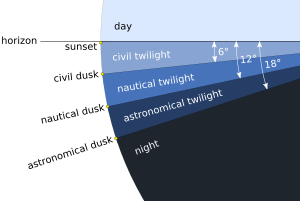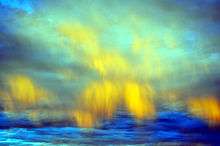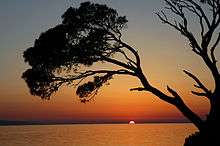Sunset
Sunset or sundown is the daily disappearance of the Sun below the horizon as a result of Earth's rotation. The Sun will set exactly due west at the equator on the spring and fall equinoxes, each of which occurs only once a year.

The time of sunset is defined in astronomy as the moment when the trailing edge of the Sun's disk disappears below the horizon. Near to the horizon, atmospheric refraction causes the ray path of light from the Sun to be distorted to such an extent that geometrically the Sun's disk is already about one diameter below the horizon when a sunset is observed.
Sunset is distinct from twilight, which has three phases, the first being civil twilight, which begins once the Sun has disappeared below the horizon, and continues until it descends to 6 degrees below the horizon; the second phase is nautical twilight, between 6 and 12 degrees below the horizon; and the third is astronomical twilight, which is the period when the Sun is between 12 and 18 degrees below the horizon.[1] Dusk is at the very end of astronomical twilight, and is the darkest moment of twilight just before night.[2] Night occurs when the Sun reaches 18 degrees below the horizon and no longer illuminates the sky.
Locations north of the Arctic Circle and south of the Antarctic Circle experience no sunset or sunrise on at least one day of the year, when the polar day or the polar night persists continuously for 24 hours.
Sunset creates unique atmospheric conditions such as the often intense orange and red colors of the Sun and the surrounding sky.
Occurrence

The time of sunset varies throughout the year, and is determined by the viewer's position on Earth, specified by longitude and latitude, and elevation. Small daily changes and noticeable semi-annual changes in the timing of sunsets are driven by the axial tilt of Earth, daily rotation of the Earth, the planet's movement in its annual elliptical orbit around the Sun, and the Earth and Moon's paired revolutions around each other. During winter and spring, the days get longer and sunsets occur later every day until the day of the latest sunset, which occurs after the summer solstice. In the Northern Hemisphere, the latest sunset occurs late in June or in early July, but not on the summer solstice of June 21. This date depends on the viewer's latitude (connected with the Earth's slower movement around the aphelion around July 4). Likewise, the earliest sunset does not occur on the winter solstice, but rather about two weeks earlier, again depending on the viewer's latitude. In the Northern Hemisphere, it occurs in early December or late November (influenced by the Earth's faster movement near its perihelion, which occurs around January 3).
Likewise, the same phenomenon exists in the Southern Hemisphere, but with the respective dates reversed, with the earliest sunsets occurring some time before June 21 in winter, and latest sunsets occurring some time after December 21 in summer, again depending on one's southern latitude. For a few weeks surrounding both solstices, both sunrise and sunset get slightly later each day. Even on the equator, sunrise and sunset shift several minutes back and forth through the year, along with solar noon. These effects are plotted by an analemma.[3][4]
Neglecting atmospheric refraction and the Sun's non-zero size, whenever and wherever sunset occurs, it is always in the northwest quadrant from the March equinox to the September equinox, and in the southwest quadrant from the September equinox to the March equinox. Sunsets occur almost exactly due west on the equinoxes for all viewers on Earth. Exact calculations of the azimuths of sunset on other dates are complex, but they can be estimated with reasonable accuracy by using the analemma.
As sunrise and sunset are calculated from the leading and trailing edges of the Sun, respectively, and not the center, the duration of a daytime is slightly longer than nighttime (by about 10 minutes, as seen from temperate latitudes). Further, because the light from the Sun is refracted as it passes through the Earth's atmosphere, the Sun is still visible after it is geometrically below the horizon. Refraction also affects the apparent shape of the Sun when it is very close to the horizon. It makes things appear higher in the sky than they really are. Light from the bottom edge of the Sun's disk is refracted more than light from the top, since refraction increases as the angle of elevation decreases. This raises the apparent position of the bottom edge more than the top, reducing the apparent height of the solar disk. Its width is unaltered, so the disk appears wider than it is high. (In reality, the Sun is almost exactly spherical.) The Sun also appears larger on the horizon, an optical illusion, similar to the moon illusion.
Locations north of the Arctic Circle and south of the Antarctic Circle experience no sunset or sunrise at least one day of the year, when the polar day or the polar night persist continuously for 24 hours.
Colors

As a ray of white sunlight travels through the atmosphere to an observer, some of the colors are scattered out of the beam by air molecules and airborne particles, changing the final color of the beam the viewer sees. Because the shorter wavelength components, such as blue and green, scatter more strongly, these colors are preferentially removed from the beam.[5] At sunrise and sunset, when the path through the atmosphere is longer, the blue and green components are removed almost completely, leaving the longer wavelength orange and red hues we see at those times. The remaining reddened sunlight can then be scattered by cloud droplets and other relatively large particles to light up the horizon red and orange.[6] The removal of the shorter wavelengths of light is due to Rayleigh scattering by air molecules and particles much smaller than the wavelength of visible light (less than 50 nm in diameter).[7][8] The scattering by cloud droplets and other particles with diameters comparable to or larger than the sunlight's wavelengths (> 600 nm) is due to Mie scattering and is not strongly wavelength-dependent. Mie scattering is responsible for the light scattered by clouds, and also for the daytime halo of white light around the Sun (forward scattering of white light).[9][10][11] Sunset colors are typically more brilliant than sunrise colors, because the evening air contains more particles than morning air.[5][6][8][11]
Ash from volcanic eruptions, trapped within the troposphere, tends to mute sunset and sunrise colors, while volcanic ejecta that is instead lofted into the stratosphere (as thin clouds of tiny sulfuric acid droplets), can yield beautiful post-sunset colors called afterglows and pre-sunrise glows. A number of eruptions, including those of Mount Pinatubo in 1991 and Krakatoa in 1883, have produced sufficiently high stratospheric sulfuric acid clouds to yield remarkable sunset afterglows (and pre-sunrise glows) around the world. The high altitude clouds serve to reflect strongly reddened sunlight still striking the stratosphere after sunset, down to the surface. Sometimes just before sunrise or after sunset a green flash can be seen.[12]

Some of the most varied colors at sunset can be found in the opposite or eastern sky after the Sun has set during twilight. Depending on weather conditions and the types of clouds present, these colors have a wide spectrum, and can produce unusual results.
Names of compass points
In some languages, points of the compass bear names etymologically derived from words for sunrise and sunset. The English words "orient" and "occident", meaning "east" and "west", respectively, are descended from Latin words meaning "sunrise" and "sunset". The word "levant", related e.g. to French "(se) lever" meaning "lift" or "rise" (and also to English "elevate"), is also used to describe the east. In Polish, the word for east wschód (vskhud), is derived from the morpheme "ws" – meaning "up", and "chód" – signifying "move" (from the verb chodzić – meaning "walk, move"), due to the act of the Sun coming up from behind the horizon. The Polish word for west, zachód (zakhud), is similar but with the word "za" at the start, meaning "behind", from the act of the Sun going behind the horizon. In Russian, the word for west, запад (zapad), is derived from the words за – meaning "behind", and пад – signifying "fall" (from the verb падать – padat'), due to the act of the Sun falling behind the horizon.
Historical view
The 16th-century astronomer Nicolaus Copernicus was the first to present to the world a detailed and eventually widely accepted mathematical model supporting the premise that the Earth is moving and the Sun actually stays still, despite the impression from our point of view of a moving Sun.[13]
Planets

Sunsets on other planets appear different because of differences in the distance of the planet from the Sun and non-existent or differing atmospheric compositions.
Mars
On Mars, the setting Sun appears about two-thirds the size it appears on Earth[14] because of its greater distance from the Sun, but at least some Martian sunsets last significantly longer and appear far redder than is typical on Earth.[15]
The reasons for the colors of the Martian sunset are different to the processes occurring on Earth. Mars has a thin atmosphere, lacking oxygen and nitrogen, so the light scattering is not dominated by a Rayleigh Scattering process. Instead the air is full of red dust which is hoisted into the atmosphere from the ground by high speed winds [15] so its sky color is mainly determined by a Mie Scattering process. One study also reported that Martian dust high up in the atmosphere can reflect sunlight up to two hours after the sun has set, casting a diffuse glow across the land.[15]
Gallery
|
See also
- Afterglow
- Analemma
- Astronomy on Mars
- Dawn
- Daytime
- Diffuse sky radiation
- Dusk
- Earth's shadow, visible at sunset
- Golden hour
- Sundown town
- Sunrise
- Sunrise equation
- Twilight
References
- ↑ "Definitions from the US Astronomical Applications Dept (USNO)". Retrieved 2016-06-17.
- ↑ "Full definition of Dusk".
- ↑ Starry Night Times – January 2007 (explains why Sun appears to cross slow before early January)
- ↑ The analemma, elliptical orbit effect. 'July 3rd to October 2nd the sun continues to drift to the west until it reaches its maximum "offset" in the west. Then from October 2 until January 21, the sun drifts back toward the east'
- 1 2 K. Saha (2008). The Earth's Atmosphere – Its Physics and Dynamics. Springer. p. 107. ISBN 978-3-540-78426-5.
- 1 2 B. Guenther, ed. (2005). Encyclopedia of Modern Optics. Vol. 1. Elsevier. p. 186.
- ↑ "Hyperphysics, Georgia State University". Hyperphysics.phy-astr.gsu.edu. Retrieved 2012-04-07.
- 1 2 Craig Bohren (ed.), Selected Papers on Scattering in the Atmosphere, SPIE Optical Engineering Press, Bellingham, WA, 1989
- ↑ Corfidi, Stephen F. (February 2009). "The Colors of Twilight and Sunset". Norman, OK: NOAA/NWS Storm Prediction Center.
- ↑ "Atmospheric Aerosols: What Are They, and Why Are They So Important?". nasa.gov. August 1996.
- 1 2 E. Hecht (2002). Optics (4th ed.). Addison Wesley. p. 88. ISBN 0-321-18878-0.
- ↑ "Red Sunset, Green Flash".
- ↑ "The Earth Is the Center of the Universe: Top 10 Science Mistakes". Science.discovery.com. 2012-01-23. Retrieved 2012-04-07.
- ↑ "A Moment Frozen in Time". Jet Propulsion Laboratory. June 10, 2005. Retrieved September 7, 2011. This article incorporates text from this source, which is in the public domain.
- 1 2 3 Nemiroff, R.; Bonnell, J., eds. (June 20, 2005). "Sunset Over Gusev Crater". Astronomy Picture of the Day. NASA. Retrieved September 6, 2011. This article incorporates text from this source, which is in the public domain.
External links
| Wikiquote has quotations related to: Sunset |
| Look up sunset in Wiktionary, the free dictionary. |
| Wikimedia Commons has media related to Sunset. |
| Wikimedia Commons has media related to Sunset. |
- Full physical explanation in simple terms
- The colors of twilight and sunset
- Complete Sun and Moon Data for One Day by The United States Naval Observatory









